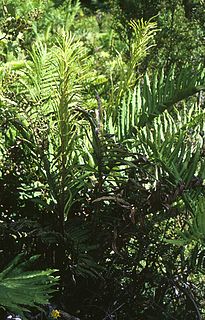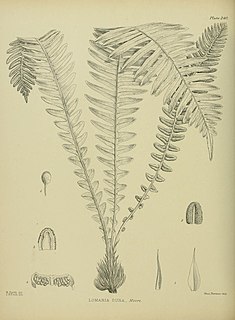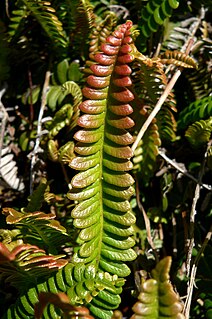
Blechnaceae is a family of ferns in the order Polypodiales, with a cosmopolitan distribution. Its status as a family and the number of genera included have both varied considerably. In the Pteridophyte Phylogeny Group classification of 2016, the family has 24 genera, and excludes genera placed in the separate family Onocleaceae. The family is divided into three subfamilies, including Blechnoideae s.s. Alternatively, the entire family may be treated as the subfamily Blechnoideae s.l. of a very broadly defined family Aspleniaceae, and include genera others place in Onocleaceae.
Water fern is a common name for several plants and may refer to:

Migidae, also known as tree trapdoor spiders, is a family of spiders with about 100 species in eleven genera. They are small to large spiders with little to no hair and build burrows with a trapdoor. Some species live in tree fern stems. They have a Gondwanan distribution, found almost exclusively on the Southern Hemisphere, occurring in South America, Africa, Madagascar, Australia, New Zealand and New Caledonia.
Blechnum petiolare is a species of fern in the family Blechnaceae. It is endemic to Ecuador and known only from Bolívar Province. When it was first described in the early 20th century, it was known from Chillanes but this area has been heavily disturbed and the species continues to be threatened.
Austroblechnum divergens, synonyms including Blechnum divergens, Blechnum rimbachii and Blechnum floresii, is a species of fern in the family Blechnaceae.

Cranfillia fluviatilis, synonym Blechnum fluviatile, is a fern known in the Māori language as kiwikiwi. A herbaceous plant, C. fluviatilis is a "hard fern" of the genus Cranfillia in the family Blechnaceae. It was identified by Patrick Brownsey in 1979. Other common names are star fern, creek fern, kawakawa and kiwakiwa.

Parablechnum cordatum, the Chilean hard fern or costilla de vaca, is a fern of the family Blechnaceae, native to Chile. It is also found in neighboring areas of Argentina and the Juan Fernández Islands.

Katie Cherie Duncan is a New Zealand footballer who plays as a defensive midfielder for Onehunga Sports and the New Zealand national team.

Austroblechnum durum, synonym Blechnum durum, is a species of fern in the family Blechnaceae. The fern is endemic to New Zealand.

Austroblechnum lanceolatum, synonym Blechnum chambersii, is a species of fern within the family Blechnaceae, found in Australia, New Zealand, Samoa and Fiji.

Austroblechnum penna-marina, synonym Blechnum penna-marina, known as Antarctic hard-fern, alpine water fern and pinque, is a species of fern in the family Blechnaceae, with a natural range from the Araucanía Region to the south and from the coast to the tree line of the Magellanic forests in Chile and adjacent areas of Argentina. It is also found in New Zealand, Australia and some Pacific islands. It is evergreen and grows to 20 cm (8 in).

Austroblechnum patersonii, synonym Blechnum patersonii, is a fern in the family Blechnaceae. It is known as the strap water-fern.

Austroblechnum colensoi, synonym Blechnum colensoi, also known as Colenso's hard fern, waterfall fern or peretao is a species of fern native to New Zealand. It is distributed throughout the North, South and Stewart Islands.

Friedrich Leybold was a German-Chilean pharmacist and naturalist.

Austroblechnum is a genus of ferns in the family Blechnaceae, subfamily Blechnoideae, according to the Pteridophyte Phylogeny Group classification of 2016. The genus is accepted in a 2016 classification of the family Blechnaceae, but other sources sink it into a very broadly defined Blechnum, equivalent to the whole of the PPG I subfamily.
Austroblechnum lehmannii is a species of fern in the family Blechnaceae. It is native to Mexico, Central America, South America and the Galápagos Islands.
Nicole Ellen Stratford is a New Zealand association footballer who plays as a defender for German 2. Frauen-Bundesliga club FC Carl Zeiss Jena and the New Zealand women's national team.

Roaring Billy Falls is a waterfall in Mount Aspiring National Park, Westland District, New Zealand. It is located in the Haast River valley, around 30 km (19 mi) inland from Haast, near Eighteen Mile Bluff on State Highway 6. The falls are a 30-metre-high (98 ft) cascade on The Roaring Billy stream. The bottom of the cascade is at an elevation of around 80 metres (262 ft) where it flows into the Haast River.












